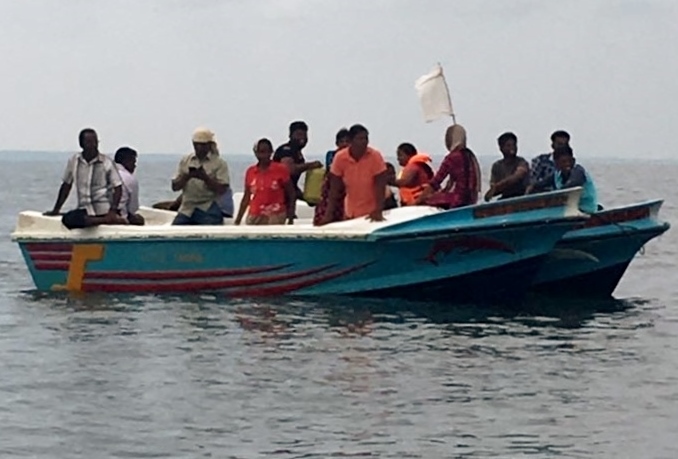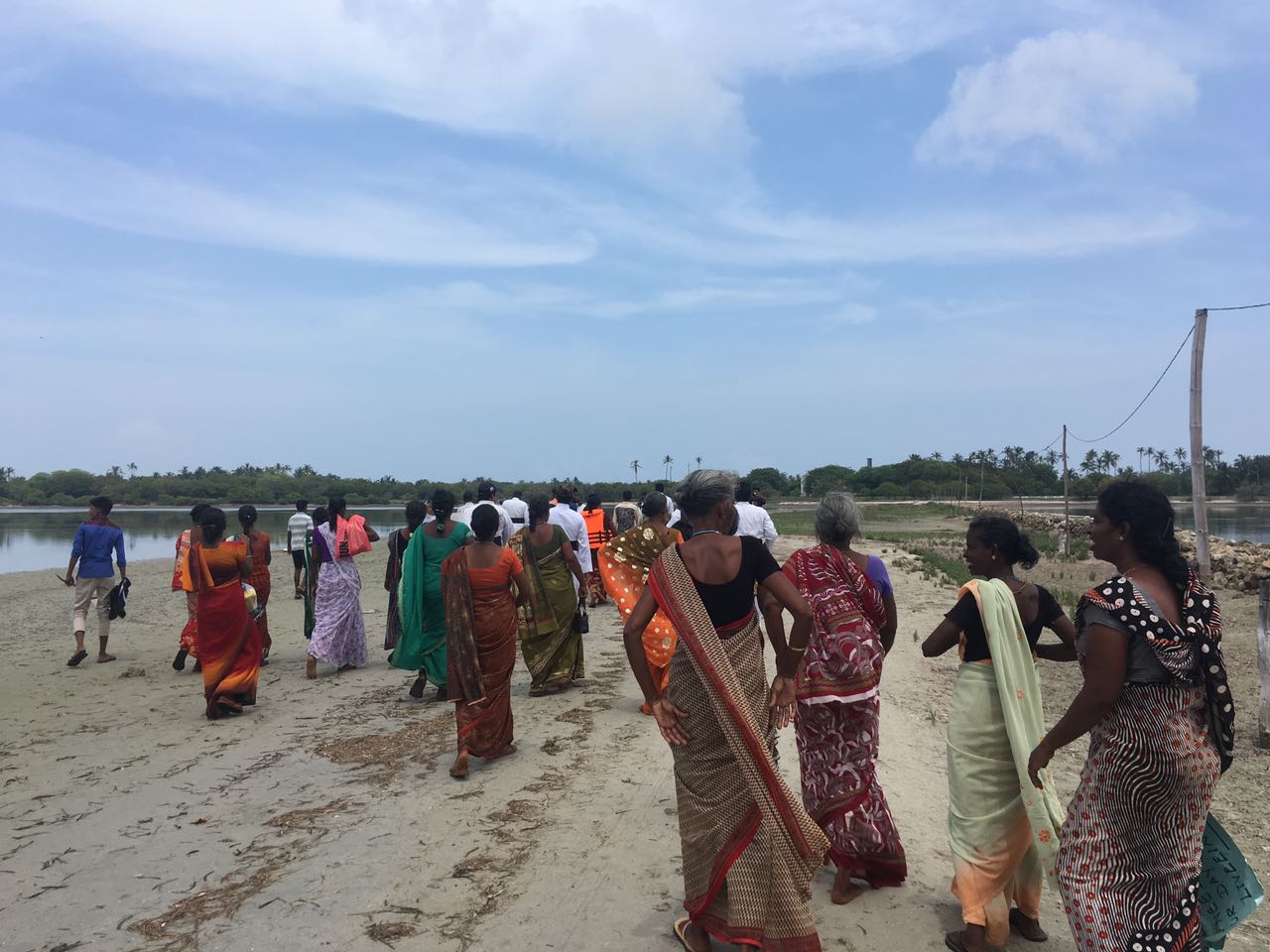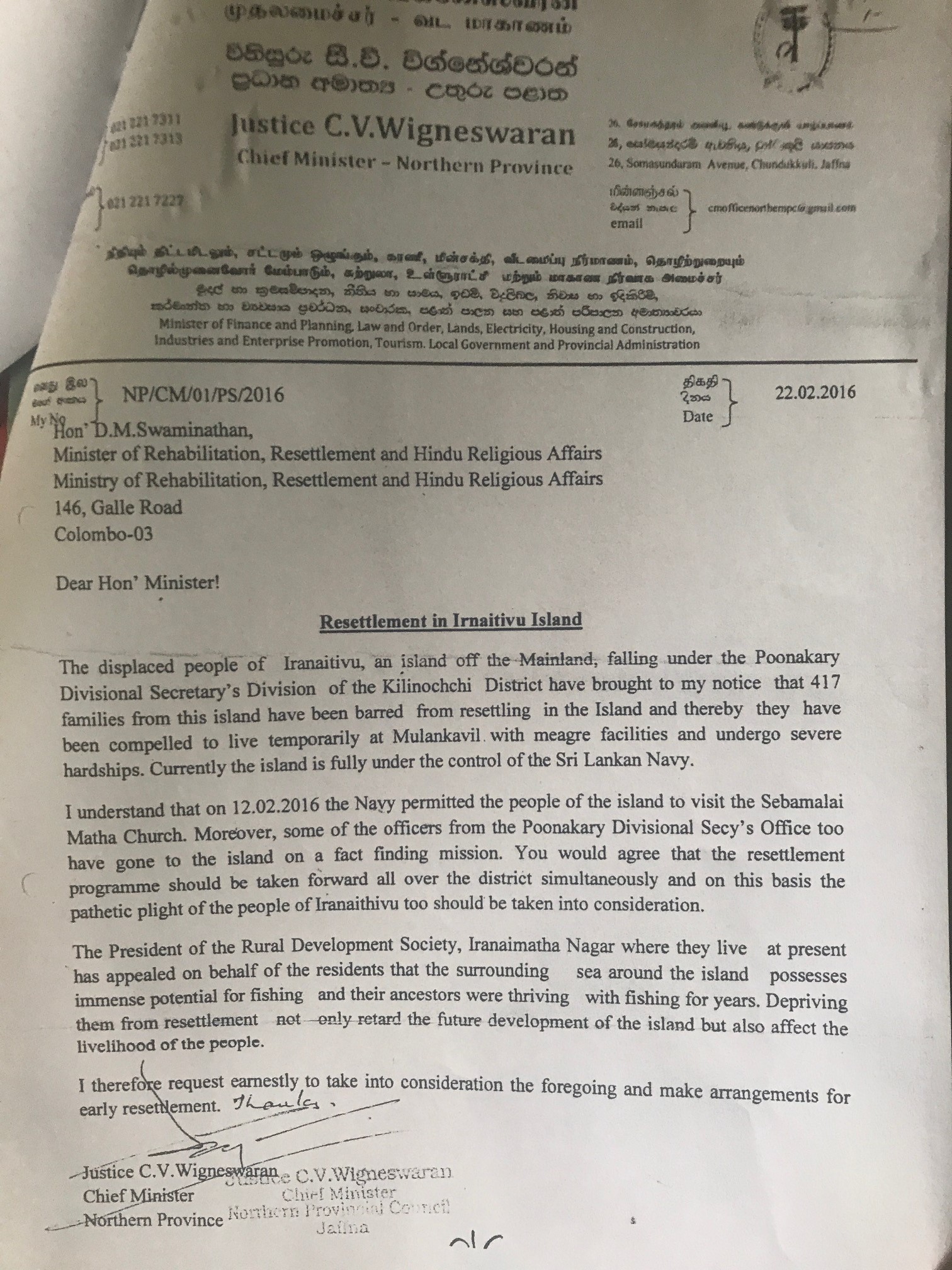
Villagers from Iranaitivu staged a massive protest this week, sailing to their island which is occupied by the Sri Lankan military and marching to their homes, refusing to leave until they are guaranteed their land will be returned to them.
In a striking and daring demonstration on Monday some 300 Tamils sailed to the island, which has been occupied by the Sri Lankan navy for years. Villagers marched from their protest site on the Kilinochchi district mainland to the coastline where their fishing boats had docked.
The villagers have held a continuous protest at a church on the mainland for 359 days, demanding a return to their land.
However, there has been little response from the navy and no signs that that their land would be returned to them.
 |
 |
 This week, frustrated villagers had grown tired of waiting.
This week, frustrated villagers had grown tired of waiting.
They attached white flags to the front of the dozens of fishing boats that were lined up and made their way towards the island. Wary of a heavy handed military response, the white flags signalled the peacefulness of their demonstration.
As they sailed towards the Iranaitivu coast, a navy patrol boat that was at the dock moved away.
Exuberant, the villagers landed their boats and made their way to the church situated by the coast.

A brave return
Many of the Tamils had been displaced multiple times during the armed conflict beginning in 1992, when some 200 families had moved off the island. Despite this they continued to move between the island and the mainland, with the island being their primary source of livelihood throughout the armed conflict.

Some of the families that returned on Monday had been trapped in the final conflict zone on the east coast in May 2009, where tens of thousands of Tamil civilians had been massacred. After being held in displacement camps, they finally began to make their way back to their hometowns. When they returned, they found the navy was refusing them all access to the island, leaving as many as 417 families displaced.
They have only been allowed to come to the island once a year since then, strictly to visit the church for Good Friday. On some occasions they were granted permission by the military to spend the night in their hometown, but on others occasions they were not even allowed that.
On Monday, prayers were held at the church once again. Though damaged and dilapidated it was still standing, unlike many of the other buildings across the island. “Hearing the church bells toll today with all of us here like this, I finally feel at peace,” said one elderly villager.


Outside navy officers gathered shortly afterwards, to try and negotiate with the villagers. Local leaders and lawyers told the Sri Lankan military that all the villagers wanted was to return to land that was rightfully theirs.
Finally, the navy agreed that they would speak to their commander and the government about what could be done, allowing only those with land deeds to stay.

‘From our island we did it all’
The villagers meanwhile marched back to their homes, some after 25 years. Many were excited to finally see and explore their home island, after years of being refused access to it due to navy occupation.
Having been displaced for years, many are struggling with poverty. Returning to the island reminded many of the abundance that it holds. Villagers broke fresh coconuts and gathered aloe vera. Women meanwhile walked along the coast, returning to catch prawns, crabs, mussels and sea cucmbers. For the over 60 women headed households from Iranaitivu, the island provided much of their livelihood.
As boats landed on the shore, one man reached into the water and pulled out a sea cucumber prompting one of the woman protestors to shout, “see the abundance of our island! We are home.” Sea cucumbers sell for Rs. 1,000 each – a lucrative catch and in abundance in the shallow waters around the island.
 |
 |
“We women used to be able to do work and not have to rely on the men,” said one protester. “From our island we did it all... We don’t want to be dependent.”
But forced away from the island, leaving behind their homes, cattle and livelihoods, many are struggling and the future remains uncertain.
An uncertain future
Some 100 Tamils spent the night at their homes on the island and are still waiting to hear from the Sri Lankan navy and the government on whether a decision has been made to release their land.
Almost a year on from their continuous protest, the villagers are desperate to return.
Their struggle has been raised by many, including the European Union’s Political, Trade and Communications Section head in Sri Lanka, Paul Godfrey and the Chief Minister of the Northern Province, C V Wigneswaran.
 |
 |
Despite the high profile calls for action, little has been done to release the island. The Sri Lankan military continues to hold on to vast swathes of land across the North-East. The government claims much of the land the military holds is being released, yet thousands of acres remain under occupation. Just last week, two days after releasing around 683 acres from the 28-year occupation of land in Jaffna, Sri Lankan soldiers blocked off access and reoccupied several areas, after the commander of Sri Lanka’s army warned that the military would be able to take back what it 'granted' to the Tamil people.
The US State Department highlighted the issue in its annual human rights report released this month, stating that “With the amount of remaining land in dispute, many of those affected by the High Security Zones complained that the pace at which the government demilitarized land was too slow and that the military held lands it viewed as economically valuable”.
Though it remains to be seen how the government and military will act, for the people of Iranaitivu this week’s protest marks a small but significant victory.
"It was incredible to see Tamil women leading this resistance and reminding us of the strength and power of the Tamil community,” said Dharsha Jegatheeswaran, the Research Director of the Jaffna-based Adayaalam Centre for Policy Research who accompanied the protesters on Monday.
“Their refusal to lie down and have their rights impinged by militarisation should be an inspiration for all of us going forward."

